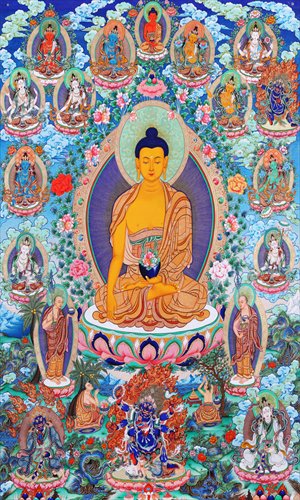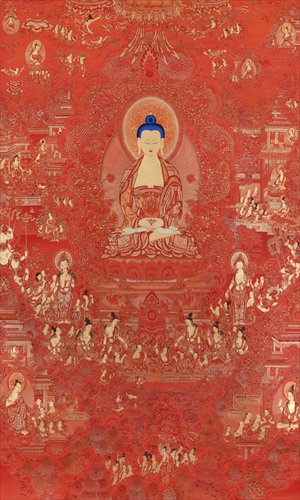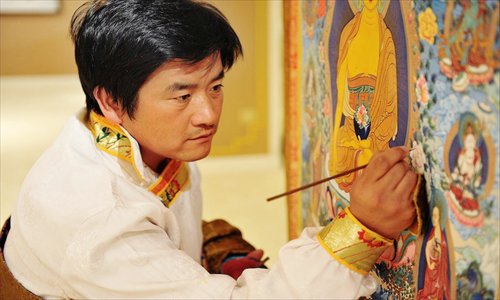Religious art form transcends boundaries



Religious art form transcends boundaries
Once sacred, Thangka paintings take on secularized market
Though a favorite for collectors at the present, Thangka remains an obscure art beyond the Tibetan areas, not palpable to people outside the industry.
An effort is being made at the Grand Hotel Beijing, where over 30 pieces of selected Thangka paintings by two artists are exhibited.
Chudri and Tashi Gyatso, two brothers from Qinghai Province, learned the technique for painting Thangka, a type of religious scroll painting mounted on colorful satin and fabric and hung for worship, 30 years ago. They opened a studio that has over 200 students enrolled.
Xue Ping, director of Chenlon Chosen Art Gallery, sponsor of the exhibition, said he hopes more people learn about and protect Thangka. He is planning on exhibiting the art in Italy, France and the UK, to show the development of Thangka in China.
In the past decade, Thangka has taken off rapidly, but meanwhile, the traditional religious aspects of the art are becoming secularized.
Buddhist art
A unique painting style in Tibetan culture, Thangka is popular among tourists. Once used mainly for religious purpose, Thangka is increasingly accepted by the mainstream.
The paintings, which have a history of over 1,300 years, mainly concern Tibetan Buddhism while reflecting Tibetan history, politics, culture and social life. Thangka is dubbed the "encyclopedia of Tibet." It is also called a "moving niche for Buddha," because it is a replacement for the copper or wooden figures of Buddha.
Several main schools gradually took shape in its development, such as Miantang, Miansa, Qinze and Jiugang Schools.
In 2006, Thangka was among the first group listed as intangible cultural heritages under national protection, for its invaluable religious and cultural value. Thangka was once found only in Tibet, Qinghai Province, Gansu Province and areas where Tibetan Buddhism reigns.
Its outreach has since spread. There are a rising number of Thangka production centers, and prices for pieces are soaring. The art is also protected by State efforts.
"More people like this form of art and pay attention to it," said Ma Shengde, an expert in the protection of intangible cultural heritages, "The ecological environment for Thangka's development is forming."
Classic principles
Creating Thangka requires extreme patience and precision. The process is complicated, and painters have to abide to the classic principles of Tibetan Buddhism, which Thangka is based on, as well as painting techniques. The pigments are made from natural mineral materials to prevent the color from fading.
It can take months to years to finish a Thankga painting, based on its size, from several to hundreds of square centimeters. The price ranges from several hundreds to millions of yuan.
Paintings can only be drawn by hand, though painters seldom sign the paintings, a practice of Buddhism showing piety for Buddha.
Training painters for this art used to be a big problem. In the past, Thangka art was only passed down by families, excluding women. The situation has changed.
Norbu Sidar, an artist of Thangka paintings in Lhasa, Tibet, told the Global Times that Thangka paintings are now mainly passed through family inheritance and social training.
He learned Thangka principles from his grandfather at the age of 12 and has painted for almost 30 years.
Five generations of his family are devoted to the traditional Miansa School of Thangka paintings. He opened a training center for Thangka painting in 2010 and has been enrolling students, including disabled people and orphans, for free.
"There are few schools training talents in this regard," Norbu Sidar said, adding that training centers in society are driven by market demand.
"There are vocational schools and several universities that offer education in this field," Ma Shengde said, "Interested students go to Tibet and Qinghai to learn it by themselves."
It was once said that a painter needs 10 years to learn Thangka. This time frame has decreased, driven by large demand for the art. But this also means that some painters do not strictly follow Buddhist principles, the core of Thangka paintings.
The rising demand also gives rise to printed Thangka to sell to tourists.
"Thangka in various forms satisfy different consumers demand, as long as they don't mix the fake with the real," said Pema Dorje, a tour guide in Lhasa who runs a shop of traditional Tibetan art.
But Ma Shengde thinks such behavior should be prohibited.
"Thangka is noted for is its handcraft quality and strict requirements of painters. Machines will damage this."
Prudent innovation
Innovations to Thangka is underway in various aspects. Lhaug Dakpo, a Thangka artist, gradually combined modern painting techniques and changed the composition of pictures, scenery and perspective in his work, after his Thangka did not sell well.
He plans to produce a new kind of canvas that can be connected to big inkjet printers, as reported by CNTV, and computers will make it more standard. Lhaug Dakpo wants to start a company specializing in producing canvas for Thangka paintings.
Penpa, vice president of Lhasa Artists Association and a Thangka painter, incorporates new elements in his subversive creations, reported chinanews.com.
In one painting, a Buddha figures changes into a Tibetan girl surrounded by musical instruments. Penpa hopes to add planes, trains and tourists in his future painting, to reflect the development of traffic in Tibet.
For him, traditional Thangka paintings are distinctly Buddhist and tied with faith. Modernization will limit the development and spread of Thangka. He stresses the importance of keeping traditional painting techniques.
Thangka paintings often cater to tourists, with changes made in the background and designs, with only the Buddha figures kept. Ma Shengde said this might hinder Thangka.
"Innovation should be prudent and respectful. The core of Thangka is its religious aspects. It's not for mass consumption and should not cater to public demands," he said. "Our descendants should know what original Thangka looks like."